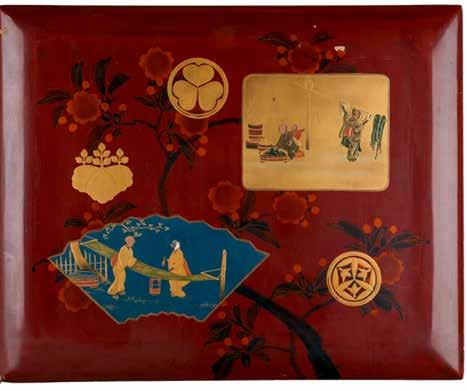
4 minute read
Contributing authors
Dr Adam Clulow is an associate professor at the University of Texas at Austin. He is the author of The company and the shogun: the Dutch encounter with Tokugawa Japan (Columbia University Press, 2014) and Amboina, 1623: conspiracy and fear on the edge of empire (Columbia University Press, 2019). He is the creator of The Amboyna Conspiracy Trial, an online interactive trial engine that received the New South Wales Premier’s History Award in 2017, and Virtual Angkor, with Tom Chandler, which received the Roy Rosenzweig Prize for Innovation in Digital History. Dr Mark K. Erdmann, a lecturer in art history at the University of Melbourne, specialises in Japanese pre-modern architecture and the intersection of space, painting, carpentry and power. His research focuses on castles, warrior residences and palaces, as well as the Jesuit mission in Japan and its impact on visual culture. He received his doctorate from Harvard University in 2016 and a master’s from the University of London, SOAS in 2001. He is currently working on a book titled Azuchi Castle: Oda Nobunaga and the origins of the Japanese castle. Erdmann is a core member of the Azuchi Screens Research Network, a group of scholars and artists attempting to discover the fate of a lost painting of Azuchi Castle gifted by Oda Nobunaga to Pope Gregory XIII, via the Jesuits, in 1585. He is also working on an annotated translation of Shōmei (Elucidation of the craft), a secret sixteenth-century architectural manual. David Forrest, CBE, is a specialist in nineteenth- and twentiethcentury Japanese woodblock prints and, together with the artist Jánis Nedéla, is currently the Director of Gallery East in Perth, established in 1991. David has presented numerous exhibitions around Australia featuring prints created during the Edo period (1615–1868) and Meiji era (1868–1912). Over the past five years he and Jánis have concentrated on researching and cataloguing warrior prints created by Utagawa Kuniyoshi (1797–1861), as well war prints created during the Sino-Japanese (1894–95) and Russo-Japanese (1904–05) wars.
Dr Jennifer Harris’s doctorate in art history examined the formation of the Japanese art collection at the Art Gallery of South Australia within national and international contexts. She was formerly a teacher of Japanese language, and a lecturer/tutor in Japanese art history at the University of Adelaide, where she is a visiting research fellow. Her MA thesis examined the nineteenth-century calligrapher, Ichikawa Beian. She is the author and curator of Netsuke and other miniatures from the Japanese collection (2014) and The power of pattern: the Ayako Mitsui Collection (2015) at the Art Gallery of South Australia. Most recently, she has been co-editor and contributor to the publication Exporting Japanese aesthetics: evolution from tradition to cool Japan (Sussex Academic, 2020). Dr Ryan Holmberg is a freelance arts and comics historian. He has taught at Duke University and the University of Tokyo, among other schools. As a freelance art historian and critic, he is a frequent contributor to The Comics Journal, Artforum International and Art in America. As an editor and translator of manga, he has worked with Breakdown Press, Drawn & Quarterly, Retrofit Comics, New York Review Comics and PictureBox on over two dozen different books. His edition of Tezuka Osamu’s The mysterious underground men (PictureBox) won the 2014 Eisner Award for Best US Edition of International Material: Asia. He is also the author of Garo manga: the first decade, 1953–1973 (Center for Book Arts, 2010) and No nukes for dinner: how one cartoonist and his country learned to distrust the atom (forthcoming). Russell Kelty is Associate Curator of Asian Art at the Art Gallery of South Australia, where he has curated and contributed to major exhibitions and catalogues, including Edo style (2018–19), Chiharu Shiota: Embodied (2018), Ever blossoming: the flower in Japanese art and culture (2016) and Treasure ships: art in the Age of Spices (2015–16). He completed an MA in Art History at the University of Adelaide, with a thesis that examined Vietnamese architectural tiles from the fifteenth to sixteenth centuries found in Indonesia. He is currently a doctoral candidate at the University of Sydney, researching the depiction of foreign ships by Japanese artists during the Edo period (1615–1868).
Advertisement
AGSA Kaurna yartangka yuwanthi. AGSA stands on Kaurna land.
Samurai transformed: warrior, culture, class, commodity is published by the Art Gallery of South Australia on the occassion of the exhibition Samurai, opening 24 July 2020.
Curator and editor: Russell Kelty
Copy editor: Penelope Curtin Designer: Antonietta Itropico Photography: Saul Steed and Stewart Adams, unless otherwise specified Colour correction: Darren Dunne Permissions: Laura Masters
© Artists, writers and the Art Gallery of South Australia, Adelaide, 2020 All rights reserved. No part of this publication may be reproduced, stored in a retrieval system, or transmitted, in any form or by any means, electronic, photocopying or otherwise, without the prior permission of the copyright holders. Images for this publication have been supplied by the authors and cultural institutions and are reproduced in good faith.
cover detail: Shunsen Natori, Japan, 1886–1960, Okochi Denjiro as Tange Sazen, 1931 or 1934 (original series 1931), Tokyo, colour woodblock print (nishiki-e); ink and colour on paper, 37.8 x 25.7 cm (image, large ōban), 40.2 x 27.3 cm (sheet); Gift of Brian and Barbara Crisp in memory of their son Andrew 2005
Art Gallery of South Australia North Terrace, Adelaide SA 5000 artgallery.sa.gov.au










